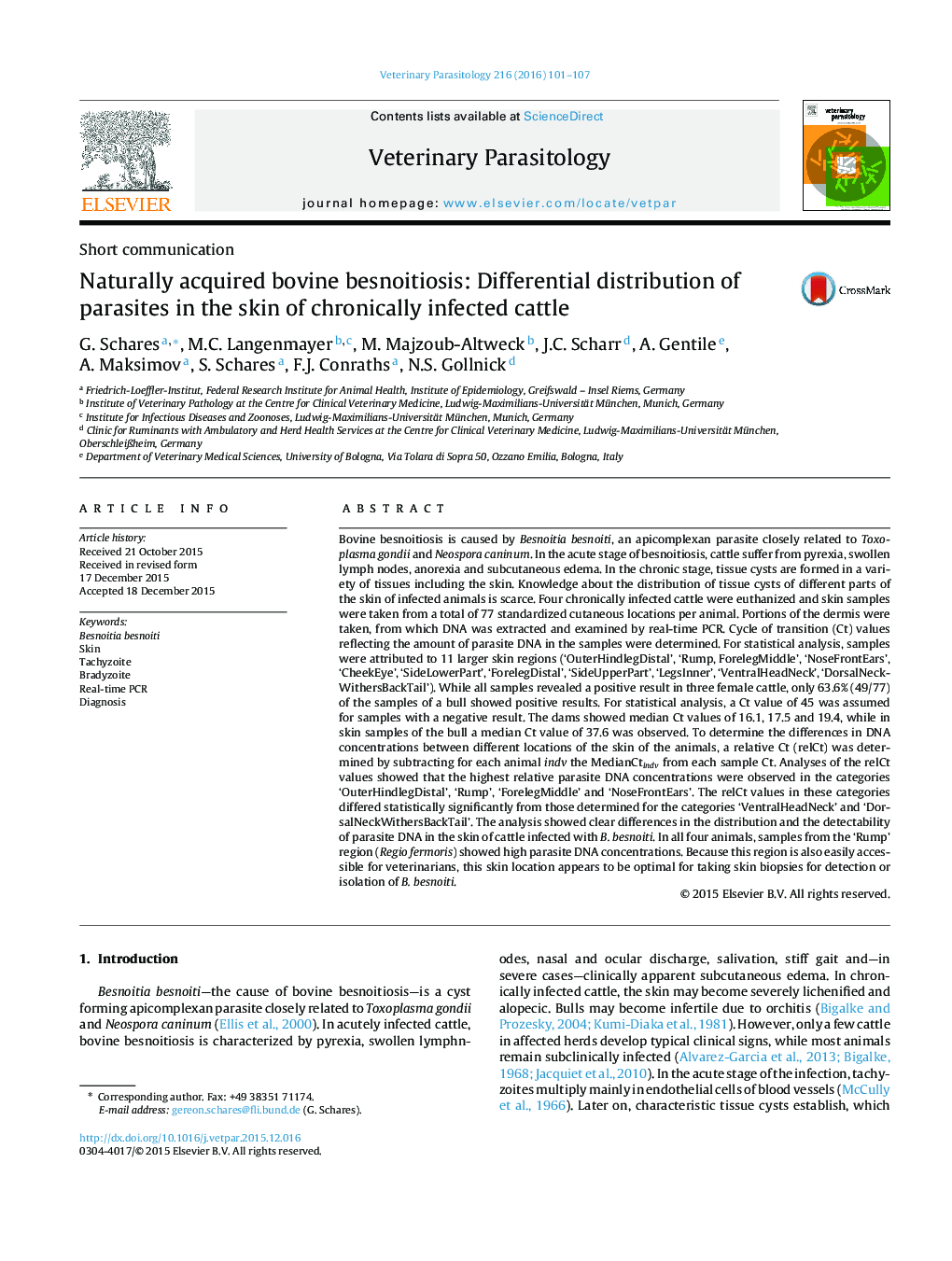| کد مقاله | کد نشریه | سال انتشار | مقاله انگلیسی | نسخه تمام متن |
|---|---|---|---|---|
| 2469969 | 1555660 | 2016 | 7 صفحه PDF | دانلود رایگان |
• Using a systematic approach, parasite concentrations in the skin of cattle chronically infected with Besnoitia besnoiti were examined.
• Using a standardized sampling protocol, 77 skin locations of four chronically infected cattle which showed macroscopic signs of besnoitiosis were analysed by real-time PCR.
• There are differences in the distribution and the detectability of parasite DNA in the skin of cattle infected with Besnoitia besnoiti.
• Results revealed that the rump region (Regio femoris) of cattle is optimal for drawing diagnostic skin biopsies.
Bovine besnoitiosis is caused by Besnoitia besnoiti, an apicomplexan parasite closely related to Toxoplasma gondii and Neospora caninum. In the acute stage of besnoitiosis, cattle suffer from pyrexia, swollen lymph nodes, anorexia and subcutaneous edema. In the chronic stage, tissue cysts are formed in a variety of tissues including the skin. Knowledge about the distribution of tissue cysts of different parts of the skin of infected animals is scarce. Four chronically infected cattle were euthanized and skin samples were taken from a total of 77 standardized cutaneous locations per animal. Portions of the dermis were taken, from which DNA was extracted and examined by real-time PCR. Cycle of transition (Ct) values reflecting the amount of parasite DNA in the samples were determined. For statistical analysis, samples were attributed to 11 larger skin regions (‘OuterHindlegDistal’, ‘Rump, ForelegMiddle’, ‘NoseFrontEars’, ‘CheekEye’, ‘SideLowerPart’, ‘ForelegDistal’, ‘SideUpperPart’, ‘LegsInner’, ‘VentralHeadNeck’, ‘DorsalNeckWithersBackTail’). While all samples revealed a positive result in three female cattle, only 63.6% (49/77) of the samples of a bull showed positive results. For statistical analysis, a Ct value of 45 was assumed for samples with a negative result. The dams showed median Ct values of 16.1, 17.5 and 19.4, while in skin samples of the bull a median Ct value of 37.6 was observed. To determine the differences in DNA concentrations between different locations of the skin of the animals, a relative Ct (relCt) was determined by subtracting for each animal indv the MedianCtindv from each sample Ct. Analyses of the relCt values showed that the highest relative parasite DNA concentrations were observed in the categories ‘OuterHindlegDistal’, ‘Rump’, ‘ForelegMiddle’ and ‘NoseFrontEars’. The relCt values in these categories differed statistically significantly from those determined for the categories ‘VentralHeadNeck’ and ‘DorsalNeckWithersBackTail’. The analysis showed clear differences in the distribution and the detectability of parasite DNA in the skin of cattle infected with B. besnoiti. In all four animals, samples from the ‘Rump’ region (Regio fermoris) showed high parasite DNA concentrations. Because this region is also easily accessible for veterinarians, this skin location appears to be optimal for taking skin biopsies for detection or isolation of B. besnoiti.
Figure optionsDownload as PowerPoint slide
Journal: Veterinary Parasitology - Volume 216, 30 January 2016, Pages 101–107
